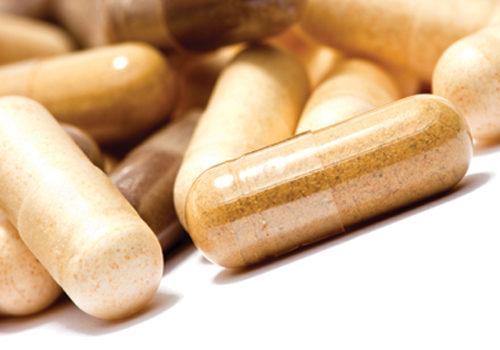Mother Nature has given us many great nutrients to support our bodies’ health and wellness. Unfortunately, she’s a bit of a trickster, as some compounds—despite their helpfulness—don’t absorb well.
Luckily, encapsulation specialists are working hard to give us great ways to deliver nutrients that not only meet our personal preferences (such as being easy to swallow, vegetarian and attractive), but also improve how vital nutrients function in our bodies.
Absorption Challenges
Missy Lowery, marketing manager at Capsugel, Americas Region, Greenwood, SC, says that the human intestine absorbs between 20% and 98% of the vitamins we take in from food. Add to that the challenge of bioavailability, which is affected by enhancers or inhibitors in foods, the form of the vitamin and a person’s individual health and ability to absorb nutrients (1).
In supplement form, Lowery feels encapsulation has an advantage for getting the job done. “In general, absorption is better when the actives are delivered in capsules,” she states. “On average, only 25% of a tablet is comprised of the actual active ingredient.” What makes up the rest could include binders, lubricants, disintegrants and surfactants. “The tablet first has to dissolve before it can be absorbed. And if a tablet fails to dissolve completely, even less of the active will be dissolved and absorbed,” states Lowery.
She adds that for this reason, herbal formulas are a prime choice for encapsulation since no pressing and binding is involved. “In many cases, herbal formulas contain actual plant leaves, stems or roots that can easily be filled into the capsules,” states Lowery. “In contrast, the compression forces required in tableting can contribute to decomposition and degradation of plant products.”
Another advantage, says Lowery, can be quicker and better absorption when liquids are involved. The reason, she feels, is that encapsulated liquids absorb quickly with fewer dissolution steps. She states, “Liquid-filled capsules have been shown to have an absorption rate of 98%.”
Problem Solving
A few especially problematic nutrients have gotten some pretty interesting workarounds for absorption.
According to CapsuleWorks, Ronkonkoma, NY, fat-soluble vitamins (like vitamins A and D) need fat for absorption. “Formulating these nutrients in a softgel, which typically contains soybean oil, provides fat for absorption,” the firm believes.
Another example is coenzyme Q10 (CoQ10), which is notorious for being slowly absorbed by the gastrointestinal tract (Tmax 5–10 hours) thanks to its high molecular weight and poor water solubility, says Lowery.
Again, CapsuleWorks offers up softgels to help: “CoQ10 is also absorbed better by the body when in a softgel delivery form because of its lipid solubility characteristics.”
Meanwhile, Lowery believes another type of capsule could help. She states, “A liquid self-micro emulsion delivery system even in a coarse emulsion and oral administration has provided a two-fold increase in bioavailability compared to a powder formulation.”
For other water-insoluble and fat-insoluble molecules like lycopene and lutein, stability can be achieved using emulsion-based systems composed of a solvent, a surfactant and a co-surfactant, according to Lowery. Meanwhile, curcumin is known to have some solubility, stability and bioavailability issues, as does milk thistle taken orally. Says Lowery, “Both products are excellent candidates for emulsion systems.”
Choices, Choices
The right capsule is crucial to protecting an ingredient’s quality and effectiveness, and ensuring effective absorption. Here are a few reasons why formulators prefer one capsule to another:
Gelatin hard capsules. Simple and effective, hard gelatin capsules are great for protecting many liquid ingredients, including specialty oils, herbal suspensions and combination products. Lowery says these capsules dissolve quickly for efficient release of the liquid contents and, because of their sealed nature, they “prevent degradation of oxygen-sensitive compounds.”
Larry Pairo, vice president of operations at AquaCap, a division of Atrium Innovations Inc., adds, “Because liquid-filled two- piece capsules do not require plasticizers, they may offer a better solution for formulas containing highly oxidative ingredients or for marketers averse to plasticizers as excipients.”
They may not be the best choice for sensitive formulations or those containing compounds that tend to bond with a gelatin capsule shell, however.
Plant-based capsules. This capsule is a match for compounds that pull moisture from their environment, and helps maintain stability and extend shelf life. Says Lowery, “For example, the low-water content of plant-based HPMC (hydroxypropyl methylcellulose) capsules can help prevent premature activation of a probiotic’s beneficial culture during storage.” Plus, they won’t crosslink with ingredients. Vegetarian capsules made of HPMC (like VCaps and DRCaps from Capsugel) are good solutions for moisture-sensitive fills, says Lowery.
Liquid-filled softgels. Barry W. Ritz, Ph.D., vice president of scientific and regulatory affairs, Atrium Innovations, headquartered in Quebec, Canada, feels liquid-filled capsules and softgels are great for delivering of “nutrients that are more suitable in a liquid format or that need to be complexed in an oil-based delivery system.” They also are easy to swallow and offer stability, odor/taste masking, protection from light degradation and more. Plus, as previously noted, softgels are great for fat-soluble nutrients, since the softgel itself often contains a lipid.
Some feel, however, the agents some companies use in softgels for elasticity “create channels in the shell wall which can lead to greater air exposure and, as a result, greater oxidation,” states Pairo. This will vary from one softgel supplier to another, however.
Time-release techniques. Capsugel has options for multi-release and time delivery like liquid capsule-within-a-capsule Pre-Pro Combo technology. “It works for incompatible ingredients or ingredients that would separate if mixed together,” says Lowery, noting that a prebiotic and probiotic combination product is a type of formula that’s compatible with this method. “A liquid prebiotic outer layer is released first to prepare the environment for the probiotic, the ingredient in the inner HPMC moisture-protective capsule that dissolves later in the intestinal tract,” she explains.
AquaCap recently developed “time-release beadlets suspended in a liquid active ingredient that allow for a multi-phase or delayed release formula,” which can be used to enhance the delivery of nutrients. Melatonin is an example. “In the initial phase, melatonin in the liquid phase quickly releases, followed by the release of the melatonin found in the beadlets at a set dose over a fixed period of time,” explains Pairo, who says this technique gives the consumer “prolonged exposure to the active ingredient, helping the consumer initially fall asleep and then stay asleep for a six to eight hour period.”
This beadlet technology is also suitable for energy formulas with active ingredients like B vitamins, arginine or caffeine at a lower dose released over an extended period of time. States Pairo, “This could present an important opportunity for marketers of energy formulas who may be looking for an effective product at a lower dose.”
Capsugel also offers a beadlet method; it combines a liquid dose for quick release and beads (in liquid or powder) for controlled or delayed release. “The thickness of the bead’s coating can be changed so that some beads dissolve as soon as the capsule ruptures, while other beads dissolve later,” Lowery explains. WF
Reference
1. C. J. Bates and H. Heseker, “Human Bioavailability of Vitamins,” Nutr. Res. Rev. 7, 93-127 (1994).
Published in WholeFoods Magazine, April 2013










